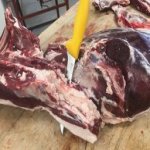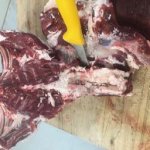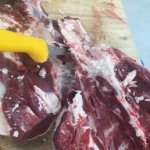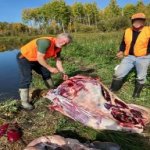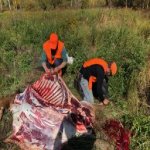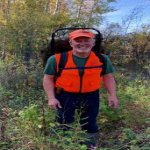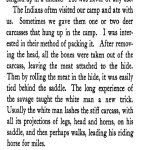- Location
- Saskatchewan
When a big animal like an elk or moose is successfully hunted, it seems like they often drop in the most inconvenient place possible. So you need a plan. I gave up long ago trying to get most whole animals out of the bush, they're just too big and heavy and hard to handle. Some hunters advocate the "gutless" method, whereby meat is stripped form the bone and all pieces bagged for transport. That makes the smallest packages, great for backpackers who need to pack out meat as light as possible but it is easy to contaminate lots of prime cuts with dirt, air exposure, and general mishaps. It is also illegal in places like BC where proof of ### must stay with the carcass. I believe meat should be hung in a cooler for a week or so to age properly, and if you do that, hanging on the bone is the best because the meat does not shorten in rigor mortis.
My family's usual method is quite different than hanging and "quartering" an animal, which I believe is a relic of the commercial domestic meat industry. Some butchers require carcasses delivered to them as if they are beef from an abattoir, and make all their cuts on a bandsaw the same as beef. If you use such a butcher, this advice is not for you. You are stuck with that type of service, and the corresponding compromise to meat quality. I'd like to suggest a better way. I come from several generations of commercial butchers, and handling meat is "in my blood" so to speak. But I do not cut game meat with a saw. I think that bone "sawdust" is very bad for meat quality. A saw is really only needed for a couple of cuts in the field. We cut all our meat using knives only. Separate into muscle groups, remove fat and contamination, then cut steaks and roasts cross grain. If a whole animal can be easily retrieved, we may not separate the carcass in the field. But for all those more typical packing jobs, this is how we do it...
The plan starts with the right equipment. Bring a half dozen good quality cotton meat bags. I prefer home made, close woven cotton over "cheesecloth" but some commercial mesh bags are OK if they are not too open weave. A folding bone saw like a Gerber exchange-a-blade saw is great for sternum, and ribs. Coarse wood saw teeth like those on the commonly available Coghlan's Sierra folding saw are too coarse for best service when cutting bone. A hatchet can work, but is heavy, leaves sharp bone shards, and is not as safe to use with bloody or cold hands. A hunting knife that has a 6" or so long fairly straight blade is better for separating the hind legs and shoulders than a shorter one, but a 4" drop point, curved blade is better for gutting and skinning. It's a picky detail but I sometimes take two knives, carry the shorter one for gutting and skinning, pack along the longer one for separating the carcass. It doesn't add much weight, and the longer straighter deboning knife stays tucked away in the pack frame anyway. Put a bundle of paracord in the pack frame too. It is handy for many things during butchering, especially hanging bagged meat in the cooling breeze until you can come for it later. And a plastic bag for liver and heart if you want to keep them.
We always tag & field dress ASAP where the animal has fallen. Especially important in early season hunts that may be 20°C. Then go for the pack frame and meat bags and buddies to help.
Cut off head, and cut legs off at the joints. Skin the top side, laying skin out flat to keep a clean surface to roll the carcass over on later. So don't step on it! Remove the top side shoulder & bag it. Remove hind leg and bag it. Most do this by finding the ball joint near the pelvis, cutting it loose with tip of your knife and and then carefully following the pelvis arch and backbone around to keep all the good sirloin steaks with the cut. An even better way that leaves less meat exposed is to remove the tenderloins and bag them, then cut through the pelvic arch with a saw, then find the sacro-iliac joint in the pelvic girdle. It's at a slight angle to the backbone and on either side of it. A properly applied knife tip will "Like magic" separate the two sides of the bony pelvis from the backbone and tail area.
Using the saw, cut off the topside rib slab close to the backbone without hitting the meaty rib steaks area. Bag it.
Flip the carcass over on the clean hide and repeat. If you followed those directions, you will be left with the long loin from which you can separate the bit of backbone and tail that is waste, and the rib&neck section. I usually spit the spine into two parts, cut crossways between the second and third ribs. the front part is the heaviest singe piece, especially on a moose because of that big neck. But it should be manageable for one person and a pack frame.
Now the real hard work begins, but all that good and well cared for meat is worth it!
My family's usual method is quite different than hanging and "quartering" an animal, which I believe is a relic of the commercial domestic meat industry. Some butchers require carcasses delivered to them as if they are beef from an abattoir, and make all their cuts on a bandsaw the same as beef. If you use such a butcher, this advice is not for you. You are stuck with that type of service, and the corresponding compromise to meat quality. I'd like to suggest a better way. I come from several generations of commercial butchers, and handling meat is "in my blood" so to speak. But I do not cut game meat with a saw. I think that bone "sawdust" is very bad for meat quality. A saw is really only needed for a couple of cuts in the field. We cut all our meat using knives only. Separate into muscle groups, remove fat and contamination, then cut steaks and roasts cross grain. If a whole animal can be easily retrieved, we may not separate the carcass in the field. But for all those more typical packing jobs, this is how we do it...
The plan starts with the right equipment. Bring a half dozen good quality cotton meat bags. I prefer home made, close woven cotton over "cheesecloth" but some commercial mesh bags are OK if they are not too open weave. A folding bone saw like a Gerber exchange-a-blade saw is great for sternum, and ribs. Coarse wood saw teeth like those on the commonly available Coghlan's Sierra folding saw are too coarse for best service when cutting bone. A hatchet can work, but is heavy, leaves sharp bone shards, and is not as safe to use with bloody or cold hands. A hunting knife that has a 6" or so long fairly straight blade is better for separating the hind legs and shoulders than a shorter one, but a 4" drop point, curved blade is better for gutting and skinning. It's a picky detail but I sometimes take two knives, carry the shorter one for gutting and skinning, pack along the longer one for separating the carcass. It doesn't add much weight, and the longer straighter deboning knife stays tucked away in the pack frame anyway. Put a bundle of paracord in the pack frame too. It is handy for many things during butchering, especially hanging bagged meat in the cooling breeze until you can come for it later. And a plastic bag for liver and heart if you want to keep them.
We always tag & field dress ASAP where the animal has fallen. Especially important in early season hunts that may be 20°C. Then go for the pack frame and meat bags and buddies to help.
Cut off head, and cut legs off at the joints. Skin the top side, laying skin out flat to keep a clean surface to roll the carcass over on later. So don't step on it! Remove the top side shoulder & bag it. Remove hind leg and bag it. Most do this by finding the ball joint near the pelvis, cutting it loose with tip of your knife and and then carefully following the pelvis arch and backbone around to keep all the good sirloin steaks with the cut. An even better way that leaves less meat exposed is to remove the tenderloins and bag them, then cut through the pelvic arch with a saw, then find the sacro-iliac joint in the pelvic girdle. It's at a slight angle to the backbone and on either side of it. A properly applied knife tip will "Like magic" separate the two sides of the bony pelvis from the backbone and tail area.
Using the saw, cut off the topside rib slab close to the backbone without hitting the meaty rib steaks area. Bag it.
Flip the carcass over on the clean hide and repeat. If you followed those directions, you will be left with the long loin from which you can separate the bit of backbone and tail that is waste, and the rib&neck section. I usually spit the spine into two parts, cut crossways between the second and third ribs. the front part is the heaviest singe piece, especially on a moose because of that big neck. But it should be manageable for one person and a pack frame.
Now the real hard work begins, but all that good and well cared for meat is worth it!















































